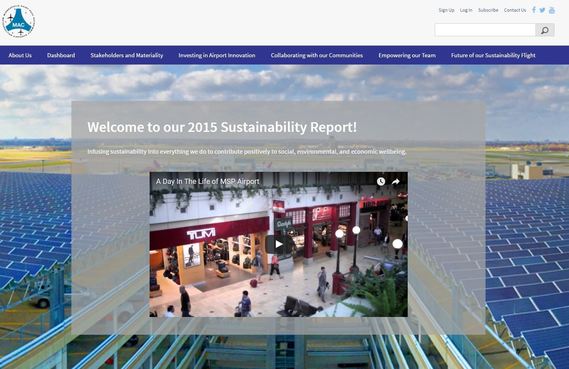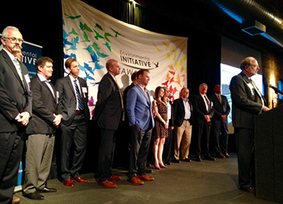
The Metropolitan Airports Commission (MAC) has published its first sustainability report for Minneapolis-St. Paul International Airport (MSP).
Covering calendar year 2015, with highlights from past years, the report focuses on the MAC’s social, environmental and economic sustainability performance.
MAC Executive Director and CEO Brian Ryks said, “This report offers a glimpse into decades of sustainability work by the MAC, and it will act as a resource as we continue to expand our engagement with airport stakeholders. It also provides a framework for future success by bringing a new level of focus, alignment and strategy to our sustainability efforts.”
“Sustainability is our approach to organizational management that recognizes the social, environmental and economic impacts our decisions have on the well-being of our system of airports and on the communities we serve,” said Dennis Probst, chief operating officer for the MAC. “By effectively considering the interdependence of these three factors, we can promote positive social engagement, protect the environment and ensure our airports’ economic viability today and into the future.”
The report is the culmination of a multi-year process that identified areas where the MAC was already practicing sustainability, but also provided an opportunity to begin planning for the future.
Through this process, the MAC developed three themes to help focus its work in achieving its vision to infuse sustainability into everything we do.
The three themes are:
- Investing in Airport Innovation: this considers how the MAC can best ensure the safety and security of its customers and employees, protect the environment, and wisely invest in its infrastructure
- Collaborating with our Communities: this considers how the MAC can best engage external stakeholders and partners, develop opportunities for collaboration, and communicate its progress with others
- Empowering our Team: this considers how the MAC can best create a culture that celebrates inclusiveness, provide growth opportunities and retain its employees, and act with vision
Looking forward, the MAC’s five-year sustainability plan includes initiatives that create opportunities for collaboration and innovation, minimize our ecological impact, ensure the longevity and sustainability of our buildings and infrastructure, and grow our employees’ contribution to and satisfaction in the workplace.
Follow along with us as we report our progress here: https://sustainability.metroairports.org.
The plan was funded, in part, by a grant
from the Federal Aviation Administration.
 Environmental Leader, an online environmental and energy management news provider, in June, selected the solar energy generation and LED lighting project at Minneapolis - St. Paul International Airport’s (MSP) Terminal 1-Lindbergh as one of its 2016 Environmental Leader Project of the Year.
This same project also received Environmental Initiative's 2016 Sustainable Business award in May. (Project participants are seen above accepting the award.)
According to Environmental Leader, winning projects provide clear, substantive environmental and financial benefits through the use of innovative technologies that are easy to implement and that result in reliable and efficient outcomes.
Environmental Initiative is a Minnesota non-profit dedicated to creating and supporting partnerships that help solve the state's environmental problems. Each year it honors 18 projects in six categories that best illustrate the power of collaboration. This particular award acknowledges collaborative efforts to pursue sustainable business practices or that offer private sector-based solutions to environmental challenges.
The solar project, which went live in December 2015, included installation of more than 8,700 solar photo-voltaic panels atop steel structures – constructed in place - on the top levels of two parking ramps at Terminal 1.
The system is expected to generate 3 megawatts of electricity every year – with the energy going to the Terminal 1 campus.
Contractors also installed 7,700 LED light fixtures throughout four parking ramps at Terminal 1. These replaced less efficient halide lights.
Altogether, the project is expected to reduce greenhouse gas emissions by 6,813 metric tons annually – the equivalent of taking 1,434 passengers off the road in one year.
Watch this video to get a closer look at the system: https://www.youtube.com/watch?v=BmN4s7FgT3A
|
 Building on its success at Terminal 1-Lindbergh, the Metropolitan Airports Commission (MAC) is about half-way through construction of a second major solar energy generation facility at Minneapolis-St. Paul International Airport (MSP) – this time at Terminal 2-Humphrey.
The Terminal 2 project is similar to that of Terminal 1. Contractors will place 3,130 photo-voltaic solar panels on a steel structure adhered to the top of a parking ramp. The project also includes replacing all 4,900 lights in the terminal’s two parking ramps.
The array is expected to add 1.3 MW of electricity annually to the solar generation output at MSP bringing the total to 4.3 MW.
Solar energy is one of the fastest-growing, sustainable clean energy sources in the world. According to the Solar Energy Industries Association, the United States is on track to double the amount of energy produced by solar by the end of 2016.
“Integrating solar into the MAC's energy strategy not only helps preserve and protect natural resources, it's a smart investment, as we plan for a day when 50 million people pass through MSP every year," said Dennis Probst, chief operating officer for the MAC.
Want to know more about how solar energy is contributing to a sustainable future in the U.S.? You'll appreciate this website: http://www.seia.org/research-resources
|
|